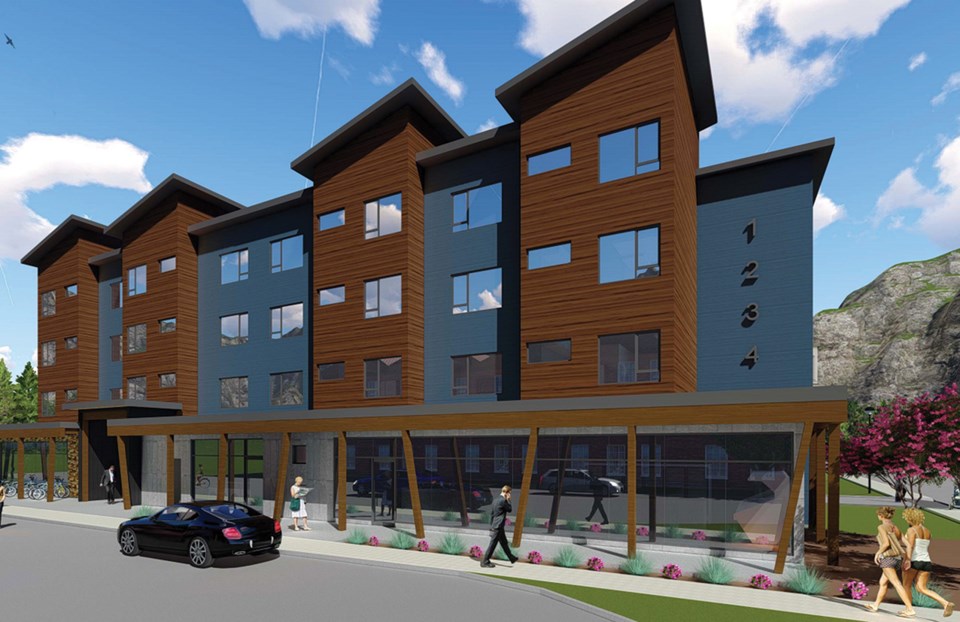The one-stop-shop facility for those in need, Under One Roof, is all but a certainty.
Council passed third reading Tuesday night of rezoning that clears the way for the unique Third Avenue development.
Coun. Susan Chapelle became emotional in voicing her support prior to her vote.
“I came from this demographic,” she said, explaining that when she was 15 years old she was given transitional housing and because of that was able to get on her feet, which led her to where she is today.
Under One Roof is a project spearheaded by the Squamish Helping Hands Society in partnership with the District of Squamish and BC Housing. It will offer centralized access to food, shelter and support services. The current Helping Hands Society shelter and the Squamish Food Bank are to be relocated to the new facility at the corner of Main Street and Third Avenue.
Forty-five units of social housing will be included. The idea of the facility is to meet people where they are at and help them get on their feet with comprehensive support, according to its proponents.
The District will donate the land while BC Housing with supply the capital costs and own the building. Squamish Helping Hands will be the facility’s operators.
Vancouver Coastal Health will operate units in the building for adults dealing with mental health and addiction issues.
Cutting Barriers, an organization that offers culinary training for those who face barriers to gainful employment, aims to operate a cooking school out of the facility.
“It is about humans helping humans,” said Renee McNeil, founder of Cutting Barriers.
A public hearing before the vote saw 20 speakers address council. About half spoke in support, while half were opposed. Council also received 50 letters for and 20 against the proposal.
Almost all who spoke against the project said they were not opposed to the facility, but were instead opposed to the location due to its lack of parking, as well as security and environmental concerns.
No on site parking is provided as part of the project, which several speakers were unhappy about, arguing that parking is already an issue in the area and this facility will only exacerbate the problem.
In the short term, the plan is for 22 spots to be located at the current Helping Hands shelter across the street.
Long term, the proposal is for a parking garage to be built downtown, thus alleviating parking pressure on the area.
In terms of security, many opposed mentioned being afraid in certain parts of downtown already and were worried this facility will add more of a negative element.
Several of the supporters and a few councillors countered that giving people housing helps them to overcome some of the concerning issues, such as addiction.
“I know that Housing First is a strategy that is working across Canada,” said Coun. Karen Elliott.
Housing first is an evidence-based strategy that is founded on the belief that when you house people and provide support, they can get their lives on track because they aren’t in survival mode any longer, according to Maureen Mackell, executive director of Squamish Helping Hands Society.
In a letter submitted to council, Mackell said she was proud to live in a community where, “absolutely everyone matters, has value, has the opportunity to contribute and where everyone deserves a warm place to sleep, nutritious food to eat and a sense of belonging and purpose.”
The Squamish Nation sent a letter of support, saying the project, “will provide much needed housing and supports for our most vulnerable citizens including some Squamish Nation members.”
An amendment to the bylaw since second reading passed on July, 4 means that the Under One Roof building can only be four storeys, not six storeys as would previously have been allowed.
The property is the site of a storm-water retention pond and its forebay – a separate smaller pond designed to remove larger particles as they enter the pond – will have to be filled in to make way for Under One Roof. This environmental concern was raised by several speakers as well.
District staff said that the storm-water situation in the area is well known and will be addressed. Relocating the forebay will cost the District roughly $330,000, according to the District report.
Under One Roof does not need a development permit as it is not located in a “form and character” development permit area.




